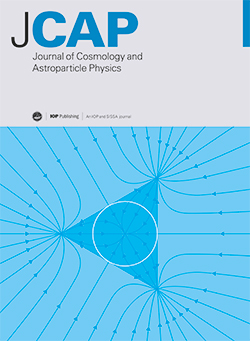Non-Gaussianity from explicit U(1)-breaking interactions
IF 5.9
2区 物理与天体物理
Q1 ASTRONOMY & ASTROPHYSICS
Journal of Cosmology and Astroparticle Physics
Pub Date : 2025-07-22
DOI:10.1088/1475-7516/2025/07/070
引用次数: 0
Abstract
We investigate primordial non-Gaussianity (NG) arising from the explicit U(1) symmetry-breaking interactions during inflation involving a nearly massless axial component of a complex scalar field P. We analyze the induced NG parameter fNL under scenarios where the axial field functions as either a curvaton or cold dark matter (CDM). In the curvaton framework, there is a conventional contribution to the local NG of fNL ≃ -O(1). Additional positive local NG can result from either the self-interactions of axial field fluctuations, their interactions with a light radial partner, or kinetic mixing with the inflaton via U(1) symmetry-breaking terms. We identify parameter regions where the interactions lead to cancellations, suppressing the overall local NG to |flocNL| ≲ O(0.1). In the CDM scenario, these interactions enhance the NG in the isocurvature fluctuations. Moreover, interactions between the axial field and another light scalar, such as a curvaton, can generate O(1) curvature NG signals and significant mixed curvature-isocurvature NGs that are within the reach of future experiments with σ(flocNL) ∼ 1. We also explore the role of a heavy radial field in generating oscillating correlation signals, noting that such signals can dominate the shape of the mixed adiabatic-isocurvature bispectrum. In certain cases, an oscillatory isocurvature bispectrum signal may be observable in the future, aiding in distinguishing between certain types of the U(1)-breaking self-interactions of the axial field.显式U(1)破缺相互作用的非高斯性
我们研究了在涉及复标量场p的几乎无质量的轴向分量的暴胀过程中由显式U(1)对称破缺相互作用引起的原始非高斯性(NG)。我们分析了轴向场作为曲率或冷暗物质(CDM)的情况下诱导的NG参数fNL。在曲率框架中,fNL的局部NG有常规的贡献。额外的正局域NG可以由轴向场波动的自相互作用、它们与光径向伙伴的相互作用或通过U(1)对称破缺项与暴胀子的动力学混合产生。我们确定了相互作用导致抵消的参数区域,将整体局部NG抑制到| ~ | > 0(0.1)。在CDM情景中,这些相互作用增强了等曲率波动中的NG。此外,轴向场与另一个光标量(如曲率)之间的相互作用可以产生O(1)曲率NG信号和显著的混合曲率-等曲率NG信号,这些信号在σ(flocNL) ~ 1的未来实验范围内。我们还探讨了重径向场在产生振荡相关信号中的作用,注意到这些信号可以主导混合绝热-等曲率双谱的形状。在某些情况下,振荡等曲率双谱信号可能在未来被观察到,有助于区分某些类型的轴向场的U(1)破断自相互作用。
本文章由计算机程序翻译,如有差异,请以英文原文为准。
求助全文
约1分钟内获得全文
求助全文
来源期刊

Journal of Cosmology and Astroparticle Physics
地学天文-天文与天体物理
CiteScore
10.20
自引率
23.40%
发文量
632
审稿时长
1 months
期刊介绍:
Journal of Cosmology and Astroparticle Physics (JCAP) encompasses theoretical, observational and experimental areas as well as computation and simulation. The journal covers the latest developments in the theory of all fundamental interactions and their cosmological implications (e.g. M-theory and cosmology, brane cosmology). JCAP''s coverage also includes topics such as formation, dynamics and clustering of galaxies, pre-galactic star formation, x-ray astronomy, radio astronomy, gravitational lensing, active galactic nuclei, intergalactic and interstellar matter.
 求助内容:
求助内容: 应助结果提醒方式:
应助结果提醒方式:


